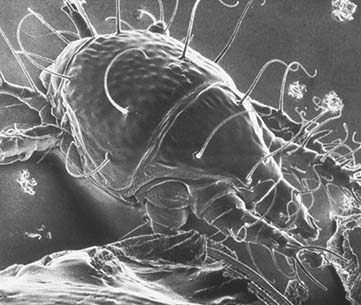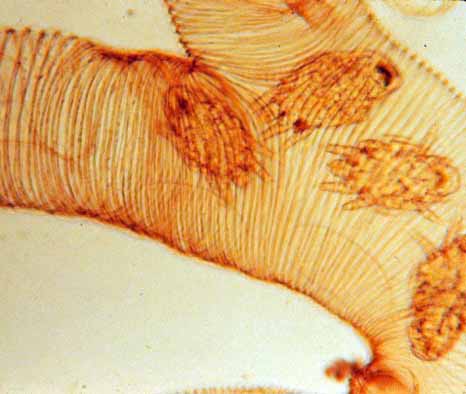
Tracheal mite (Acarapis woodi) is a microscopic, internal mite of the honey bee respiratory system, capable of infecting queen bees, drones and worker bees. Tracheal mite infects and reproduces inside the tracheae (breathing tubes) of the honey bee and feeds on the honey bee’s haemolymph (blood). Infection affects the honey bee’s capacity to breathe, opens the tracheal surface to pathogens and reduces capacity of air flow to the wing muscles. This results in weakened and sick honey bees which do not work as hard and have a significantly reduced lifespan.
When Tracheal mite infestation is combined with other stresses (eg disease, lack of pollen or nectar etc.) it can lead to the death of the colony. Once a honey bee colony is infested with Tracheal mite it remains infested, with impacts more significant over winter and early spring, contributing to high colony losses in severe cases.

Tracheal mite under scanning electron microscope. The Food and Environment Research Agency (Fera), Crown Copyright
The entire life cycle of the mite occurs within the honey bee’s tracheae (breathing tubes), except for brief migratory periods. Within the 24 hours after worker bees emerge from their cells, female mites migrate between adult bees into their tracheae and remain there for their life span or until their host bee dies. The invading mites are attracted to the current of expired air coming from the first thoracic spiracle. Once inside the host bee, each female mite lays 5 to 7 eggs over a period of 3 to 4 days and continues to lay eggs throughout her life. Eggs hatch in 3 to 4 days and progress through a larval stage, then a nymphal stage before finally reaching adult form. The male takes 11 to 12 days to fully develop, whereas the female takes 14 to 15 days. Mating then occurs within the breathing tubes. The female is capable of laying almost one egg a day, each of which is about two thirds the weight of the female herself. There are usually 2 to 4 times more females present than males and as many as 21 offspring from each female are possible. Once mated, the female mites leave the tracheae, moving to the external surface of the bee to locate a new bee and begin the reproductive cycle again.

Acarapis woodi in bee trachea under light microscope. USDA
Only the female mites disperse from the host to attach to other bees, with approximately 85 per cent of the mite transfers occurring at night. Females are particularly attracted to adults less than 3 days old with this infestation of younger bees enabling the mite more time to complete its life cycle before the host bee dies. Increasing temperatures result in an increased number of mites transferring amongst bees. The mites cannot survive longer than a few hours in this transfer process outside of an adult bee.
Honey bee colonies are more susceptible to Tracheal mite in cooler climates and during autumn, winter and early spring. This is because of the tendency of honey bee colonies to cluster together in cooler climates, allowing for the easy transfer of Tracheal mite amongst the adult honey bee population. Large variations in susceptibility to infestation exist among bees, with susceptibility to infestation diminishing rapidly from the first day of a honey bee’s life. Honey bees more than 9 days old rarely become infested. Queens also exhibit a rapid decline in susceptibility to mite infestation with increasing age.

Tracheal mite lifecycle. www.cladead.org

Healthy and Tracheal mite infested trachea. The Food and Environment Research Agency (Fera), Crown Copyright
Tracheal mites are microscopic in size and are therefore invisible to the naked eye. There are no reliable or visible diagnostic symptoms of infestation, making them difficult to detect. Tracheal mites spend their whole life inside adult honey bees, except for mature females, which have a mobile phase, and leave the host to attach to younger honey bees through bee to bee contact. Although found predominantly in the tracheae of honey bees, they are sometimes also found in the head, thoracic and abdominal air sacs.

Wings held at odd angle (‘K wing’) is a common symptom of Tracheal mites. www.beekeepingforum.org
Despite the lack of diagnostic signs, serious Tracheal mite infestation can cause general colony symptoms such as large numbers of crawling honey bees at the entrance of the hive which are unable to fly, honey bees appearing disorientated, honey bees holding their wings at odd angles (‘K wing’), large numbers of honey bees staying in the hive rather than foraging, and in extreme cases, the hive population dropping dramatically. However, these abnormalities are not always seen and may or may not be found in association with an infestation. The only accurate diagnostic method to detect Tracheal mite infestation is laboratory dissection and microscopic examination of the honey bee’s tracheae. Honey bee colonies are more susceptible to Tracheal mite in cooler climates and during autumn and winter. Large variations in susceptibility to infestation exist among bees, with susceptibility to infestation diminishing rapidly from the first day of a honey bee’s life. Honey bees more than 9 days old rarely become infested. Queens also exhibit a rapid decline in susceptibility to mite infestation with increasing age.

Tracheal mite infected worker bee (left) showing the classic K-wing symptom can be hard to detect in a colony. Rob Snyder, www.beeinformed.org
Normal thoracic tracheae are clear, colourless, or pale amber in colour. In contrast, infested tracheae show patchy discolouration and deteriorate progressively as a result of mites feeding. The tracheae of severely infested bees appear darkened with brown blotches, brown scar tissue, crust like lesions, or may appear black. Numerous mites in varying stages of development and mite debris inside the tracheae are thought to reduce capacity for airflow. To determine a 1-2 per cent infection rate in a honey bee colony, it is recommended that tracheal diagnostics are conducted on at least 50 worker bees that are collected from around the brood, as nurse bees are usually the youngest bees. This should be undertaken by an approved laboratory or your local department of agriculture.
General symptoms associated with Tracheal mite infestation such as population drop, honey bees staying in their hive and crawling and disoriented honey bees could be confused with other factors affecting honey bee colonies, such as a lack of pollen or nectar, inappropriate pesticide use or various other pests and diseases.
Tracheal mites breed and spend most of their life inside the trachea of all castes of adult honey bees. However, mated female Tracheal mites spend time outside the honey bee’s tracheae, although this is usually only for a few hours. Spread occurs rapidly within the hive through bee to bee contact, such as trophallaxis. Upon leaving the breathing tubes mated female mites climb to the tip of a body hair and then attach themselves to the hairs of a passing young bee, entering the tracheae through the thoracic spiracles. The mite needs to locate a new host within 24 hours or it will die.

Honey bees feeding and grooming are key means of spread of Tracheal mite between adult bees. Randy Oliver, www.scientificbeekeeping.com
Once an infestation is established, Tracheal mites can spread rapidly from colony to colony in an apiary, through drone and worker bee drift between hives, or through the robbing of hives. Tracheal mites can also spread to new areas through swarming or absconding honey bee colonies. Beekeepers can also inadvertently spread Tracheal mites through their apiary through normal management practices including the movement of infected colonies and bees between hives and apiaries. They can also be dispersed long distances via infected honey bees hitchhiking on clothes, equipment and vehicles.

Honey bee colonies clustering together are a critical means of spread of Tracheal mite within a colony. Randy Oliver, www.scientificbeekeeping.com
Tracheal mites can spread easily when a colony is in close proximity to each other, such as a winter cluster, and this can contribute to heavy winter losses. Always be aware of any unusually high winter losses.
Tracheal mite is not present in Australia but is found in most other honey producing regions of the world, such as Europe, North America and parts of Asia. It is not present in New Zealand.
 Tracheal mite is currently not present in Australia and there are strict quarantine requirements in place to protect the Australian honey bee industry. Surveillance programs, such as the National Bee Pest Surveillance Program are also in place in high risk ports around Australia to detect this pest if it does enter Australia and attempt to eradicate it. If you observe any symptoms that you think may be caused by Tracheal mite, call your local department of agriculture or the Exotic Plant Pest Hotline on 1800 084 881.
Tracheal mite is currently not present in Australia and there are strict quarantine requirements in place to protect the Australian honey bee industry. Surveillance programs, such as the National Bee Pest Surveillance Program are also in place in high risk ports around Australia to detect this pest if it does enter Australia and attempt to eradicate it. If you observe any symptoms that you think may be caused by Tracheal mite, call your local department of agriculture or the Exotic Plant Pest Hotline on 1800 084 881.

As their name suggests tracheal mites live inside the air ways of honey bees. Simon Hinkley and Ken Walker Museum Victoria, PADIL
In countries where Tracheal mite is present, integrated pest management can help control Tracheal mite infestations. This includes re-queening colonies that are susceptible to the disease, as colonies with young, active laying queens appear to cope with mite infestations much better than colonies with older queens. Tracheal mite resistant honey bee strains (eg Buckfast or Primorsky bees) can also be used. Tracheal mites are believed to have evolved with honey bees (Apis mellifera) and because of this, some strains of bees appear to be highly resistant to the mite. The heritability of this resistance trait is considered to be high and is thought to be primarily expressed as a self-grooming behaviour, termed auto-grooming, thus removing the migrating mites.
Another treatment option favoured in many parts of the USA is the use of oil extender patties. These are made from 1 part liquid vegetable oil with 3 parts granulated or powdered sugar. The bees come to eat the sugar and get coated in oil, which protects them from mite infestation as the mated female Tracheal mites are unable to transfer between adult bees. In the USA, oil extender patties are used in early spring and again in autumn with good results. Organic chemical treatments that contain thymol gel or formic acid are also widely used to control Tracheal mite and have been shown to be highly effective in overseas countries.
Additional fact sheets from Australia and from around the world, which provide extensive information about this pest, have been listed below. To learn more, click on the links below:
Tracheal mite, Plant Health Australia
Tracheal mite, NSW DPI
Honey bee tracheal mite, University of Florida
Tracheal mites, BeeBase
Honey bee tracheal mite, Clemson Cooperative Extension
Tracheal mites in honey bee colonies, British Columbia Ministry of Agriculture
Tracheal mites, University of Tennessee
Australian Beekeeping Guide (2014) Agrifutures Publication No. 14/098
This video was produced to help provide information about the pest’s life cycle and biology, identification and possible management options. Please be aware that the video was produced overseas, and treatment recommendations or conditions experienced may differ from those in Australia.